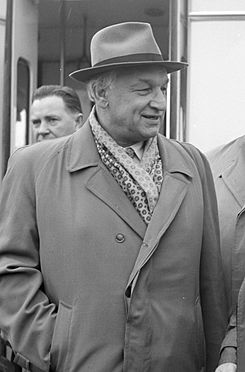Justas Paleckis facts for kids
Quick facts for kids
Justas Paleckis
|
|
|---|---|

Paleckis in 1961
|
|
| President of Lithuania (not recognized) | |
| In office 17 June 1940 – 24 August 1940 |
|
| Preceded by | Antanas Merkys |
| Succeeded by | Himself as Chairman of the Presidium of the Supreme Soviet of the Lithuanian SSR |
| Prime Minister of Lithuania (not recognized) | |
| In office 16 June 1940 – 24 August 1940 |
|
| Preceded by | Antanas Merkys |
| Succeeded by | Vincas Krėvė-Mickevičius |
| Chairman of the Presidium of the Supreme Soviet of the Lithuanian SSR | |
| In office 25 August 1940 – 14 April 1967 |
|
| Preceded by | Himself as de facto President of Lithuania |
| Succeeded by | Motiejus Šumauskas |
| Personal details | |
| Born | 10 January 1899 Telšiai, Kovno Governorate, Russian Empire |
| Died | 26 January 1980 (aged 81) Vilnius, Lithuanian SSR, Soviet Union |
| Nationality | Lithuanian |
| Political party | Lithuanian Popular Peasants' Union (1926-27) Communist Party of Lithuania (1940-80) |
Justas Paleckis (born January 10, 1899 – died January 26, 1980) was a journalist and politician from Lithuania. He became the acting president of Lithuania in 1940 after the Soviet Union took control. He served from June 17 to August 3, 1940. After this, he remained the official head of state for the Lithuanian SSR until 1967.
Contents
Early Life and Political Beginnings
Paleckis was born in Telšiai, Lithuania, in 1899. In the 1920s, he worked as a director for ELTA, which was Lithuania's official news agency. He later spoke out against the leaders of Lithuania at the time. Because of his views, he became a suitable choice for the Communist Party of Lithuania to become a leader in Lithuania. This happened during the Soviet Union's plan to take over the country in 1940. Paleckis had connections with the Lithuanian Communist Party since the early 1930s.
Soviet Takeover of Lithuania
When the Soviet Union occupied Lithuania, President Antanas Smetona fled the country. The Prime Minister, Antanas Merkys, then became the acting president. A day after Smetona left, Merkys announced he had removed Smetona from power. He then appointed Paleckis as the new prime minister. Merkys himself soon resigned, which made Paleckis also the acting president.
These actions are now seen as against the law and the constitution of Lithuania. This is because President Smetona never officially resigned from his position. Therefore, the government records of Lithuania do not recognize Paleckis as a true or legal president.
The "People's Government"
By this time, Soviet troops had already occupied Lithuania. Paleckis was made Prime Minister under direct orders from the Soviet embassy. Soviet officials worked with the Lithuanian Communist Party to set up a new government. Paleckis's cabinet served mostly to manage things. Some non-Communists were included in this first "People's Government." However, looking back, it is clear they were just for show. Their purpose was to make the Soviet takeover look more legitimate.
Sham Elections and Annexation
The Soviet Union wanted to make their takeover of the Baltic States seem legal. So, Moscow ordered Paleckis's government to hold "elections" for a "People's Seimas" (parliament). These elections took place on July 14–15. Voters were given only one list of candidates to choose from. This list included only Communists and their supporters.
When the People's Seimas met on July 21, they had only one main task. They passed a resolution declaring Lithuania a Soviet republic. They also asked to join the Soviet Union. This request was approved by everyone. A few days later, Moscow "accepted" Lithuania's request. This supported the official story that Lithuania had a socialist revolution on its own. It also claimed Lithuania then asked to join the Soviet Union.
Since 1990, Lithuania's official view is that Smetona never resigned. This means all actions leading to the Soviet takeover were invalid.
Later Political Career
Paleckis continued to serve as the head of state until 1967. His official title was Chairman of the Presidium of the Supreme Soviet of the Lithuanian SSR. In this role, he personally signed orders that allowed for the mass deportation of many important people from independent Lithuania.
For example, with his approval, Merkys and the Minister of Foreign Affairs, Juozas Urbšys, were sent away to the Russian SFSR. Many educated people and leaders of Lithuania were seen as enemies. They were among the first to be sent away or even sentenced to death. Paleckis worked closely with Soviet secret police (NKVD) officials in Lithuania. He signed documents and took responsibility for these deportations as a representative of Soviet Russia.
Between 1940 and 1953, about 132,000 Lithuanians were sent away. They were deported to far-off places in the USSR, like Siberia and Central Asia. More than 70% of these people were women and children. During the same time, another 200,000 people were put into prisons. About 150,000 of them were sent to the Gulag, which were Soviet labor camps. Most of these camps were in Siberia.
Paleckis also served as the Chairman of the Soviet of Nationalities from 1966 to 1970.
His son, Justas Vincas Paleckis, is also a politician. He has been a Member of the European Parliament.
Paleckis was also given the award of Hero of Socialist Labour of the Soviet Union.
| Party political offices
|
||
|---|---|---|
| Preceded by Jānis Peive |
Chairman of the Soviet of Nationalities August 2, 1966 – July 14, 1970 |
Succeeded by Yadgar Sadikovna Nasriddinova |
See also
 In Spanish: Justas Paleckis para niños
In Spanish: Justas Paleckis para niños

